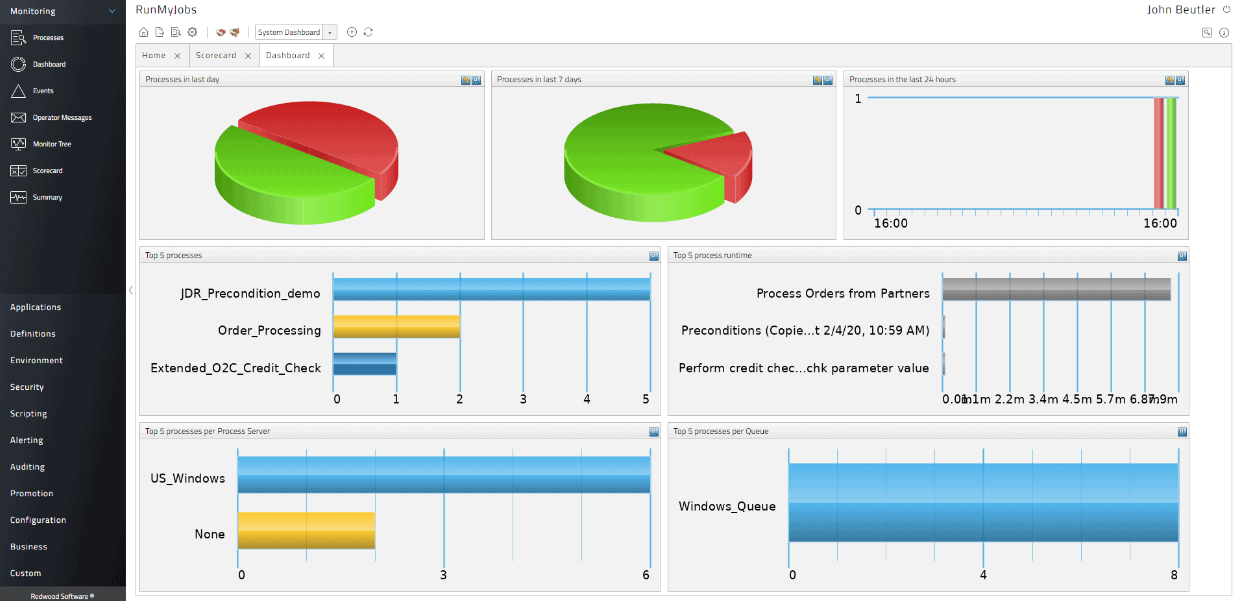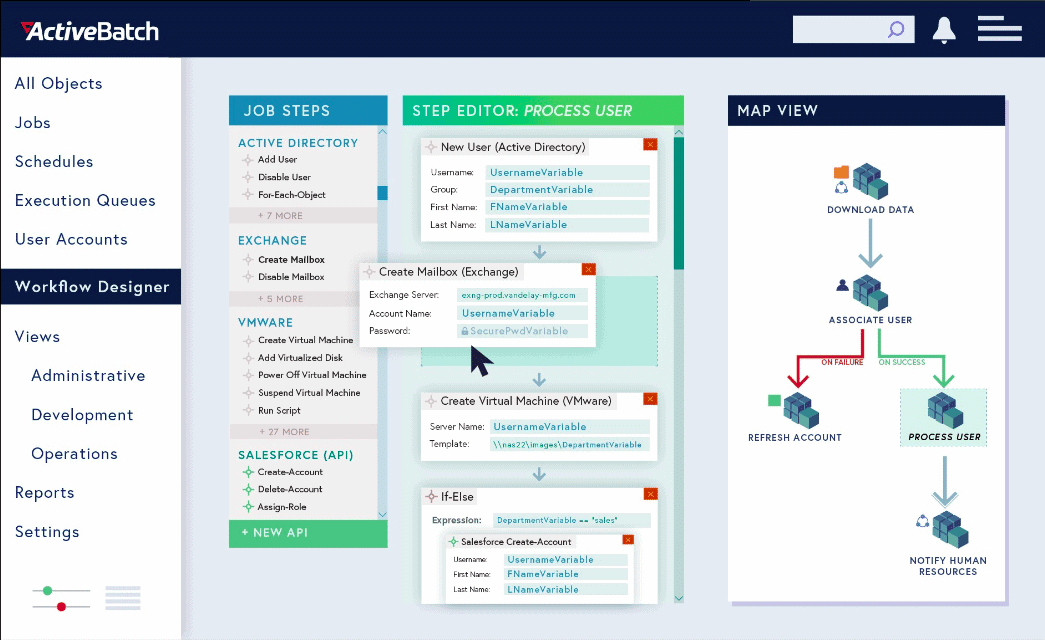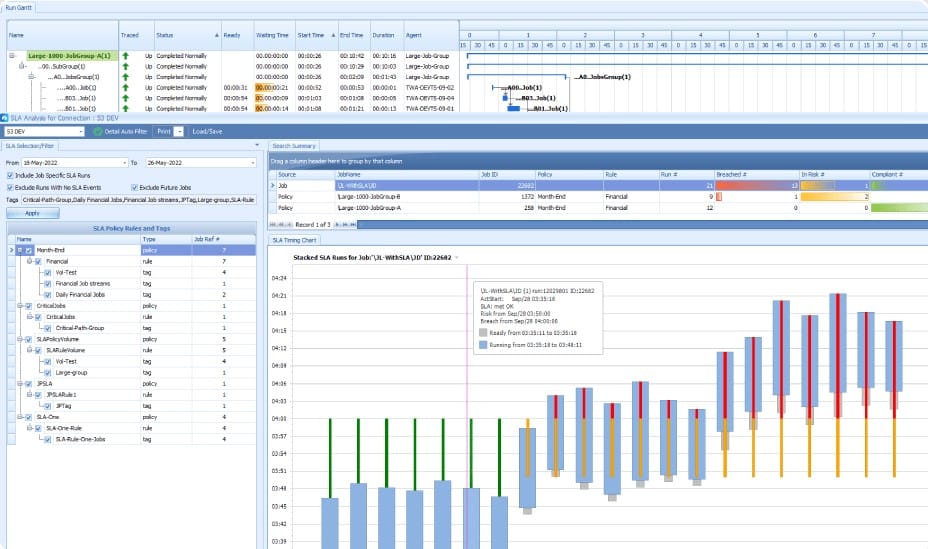We may earn a commission if you make a purchase through the links on our website.
The Best Automic Alternatives

UPDATED: March 14, 2025
Automic Automation is a service orchestration and automation platform that effectively automates your complex and diverse range of technologies, applications, and platforms to help you deliver value. In this post, we will take a look at the best Automic alternatives
It can effectively help you to manage complex workflows across business apps, ERP systems, diverse platforms, from multi-cloud, micro-services to the mainframe. Automic Automation provides much-needed reliability, speed, and agility to promote seamless business automation. It provides good data governance, self-service, and scaling functionalities to streamline big data pipelines.
With the automation and orchestration capabilities, Automic accelerates your digital transformation and helps you scale efficiently. It supports automation-as-code technology and offers good scalability, self-service, and upgrades with zero downtime.
Here is our list of the best Automic alternatives:
- Redwood RunMyJobs – EDITOR'S CHOICE This SaaS-based job scheduler and workload automation service is particularly useful for managing ERPs. Start with a free demo.
- ActiveBatch Workload Automation – GET FREE DEMO This task automation package enables the user to create a process flow by linking together different software packages and defining the inputs and output to each stage in the flow. You can get a demo.
- Tidal Workload Automation – GET FREE DEMO This software scheduler enables separate software packages to form a common platform for data processes and it can be used for software development pipelines or ERP data management, among other applications.
- Control-M A workflow orchestration platform for CI/CD pipelines that includes SLA management utilities. Installs on Windows and is also available as a cloud service.
- JAMS A flexible job scheduling service that can interface with other tools through integrations. Installs on Windows Server.
- IBM Workload Automation An automation platform that can coordinate actions in third-party packages across sites and in the cloud as well as managing workflows. This is a cloud-based platform.
- Stonebranch A SaaS platform that offers event-based scheduling over on-premises and cloud-based tasks for DevOps environments.
- AutoSys This is a DevOps project supervision system that can work with tasks carried out on-premises or on cloud platforms. Installs on Windows or on a private cloud account.
- Red Hat Ansible This task automation system can be used for configuration management and device onboarding plus secure remote access. Installs on Red Hat Enterprise Linux.
- Azure DevOps Server A great DevOps environment run on the Azure cloud platform that includes development and project management tools.
- OpCon A cross-platform job scheduler that can handle more than 140,000 jobs simultaneously. This is a cloud-based system.
Why look for Automic alternatives?
Though Automic Automation is agile, reliable, and faster, it can be quite expensive if the end-user ramps up the resources as per their needs.
Another downside of Automic Automation solutions is the lack of customer support. Most modern automation tools offer 24/7 customer support and frequent health checks by a dedicated IT team. Such proactive support is what makes the tool reliable and trustworthy.
Our methodology for selecting Automic alternatives:
We reviewed the market for Automic alternatives and analyzed tools based on the following criteria:
- Central console for controlling job scheduling and automation processes
- User-friendly and comes with batch job assembler
- Automation and scheduling capabilities as well as third-party integrations
- Real-time alert system that alerts about issues with batch processing and other events
- Runs applications and scripts on remote devices
- Free trial or a demo session for product testing
In this post, we have summed up reviews of the best Automic alternatives:
The best Automic alternatives
1. Redwood RunMyJobs – FREE DEMO
Redwood is an advanced workload automation solution that reduces unnecessary, time-consuming manual tasks. It offers automation tools for workload and scheduling and report and finance distribution. The solution is built upon a flexible, modern architecture that is meticulously designed to be deployed as-a-service to promote scalability and reap maximum benefits for enterprises. RunMyJobs keeps a clean core with direct integrations to S/4HANA or BTP and 1000+ out of the box SAP wizards and templates. It’s highly recommended for its speed to market and ease of use.
Key Features:
- Automation: Automates tasks across all environments, including cloud, hybrid, as well as on-premises
- Customer Support: Offers 24/7 support services globally to all customers
- SLA Monitoring: Helps meet important business process deadlines
- Guaranteed 99.95% Uptime: Seamless self-upgrades and constant service with few interruptions
- Uncompromising Security: Provides your data and processes extreme security with a single-tenant, security-first design, and comprehensive encryption capabilities.
Why do we recommend it?
Redwood RunMyJobs is an easy-to-use and quick automation tool that integrates well with over 1000 out-of-the-box SAP wizards and templates. It even supports REST and SOAP web services and provides easy-to-use API wizards.
It is one of the best Automic alternatives designed for workload automation and job scheduling via SaaS. It has the ability to integrate diverse technologies to boost the digital transformation processes. It provides a unified console for workflows running on-premises, in the hybrid, private and public cloud environments. It fills up the technical gaps in complex processes running between cloud, virtual, distributed, and mainframe resources.
According to the 2024 Gartner Magic Quadrant, Redwood Software leads in the automation space, positioned furthest for Completeness of Vision among the top vendors. RunMyJobs solution can be used for complex data management, hybrid cloud automation, managed file transfers, and DevOps automation.
We like Redwood RunMyJobs because it is able to link together the execution of an existing suite of software – which might be provided by different vendors – and coordinates their functions to pass through data. Redwood acts like a production line, orchestrating software so that it runs in a sequence, flowing data from one to the next, thus removing the need for manual intervention and eliminating the problem of transposition error. The SaaS package from Redwood improves efficiency and frees up staff for other tasks, making them more productive.
Who is it recommended for?
IT operations teams that manage complex data and businesses that perform repetitive tasks or batch processes across hybrid cloud might find Redwood RunMyJobs a perfect solution. Non-technical users might not find it the best solution as it comes with a wide range of advanced features that require technical expertise.
Pros:
- Easy-to-Use Interface: Offers clarity in design that makes it easier for customers to use and navigate
- Supports Integration: Works well with other applications and systems such as ERP systems
- Managed File Transfer Automation: Over 100,000 files can be moved, copied, and managed securely each month within the organization.
- Unlimited Connections: No additional licensing is required to automate any process, application, or tool.
- Simple Pricing Plans: Any size organization can use RunMyJobs because of its consumption-based pricing.
Cons:
- Unsuitable for Non-Technical Users: Designed for IT professionals in mind with advanced features. Hence, Redwood is not a perfect solution for non-technical users.
Get started with a free demo.
2. ActiveBatch Workload Automation – GET DEMO
ActiveBatch Workload Automation is powered by a strong automation engine that allows you to orchestrate any process via a central control pane. In less time, the tool helps you build low-code, reliable end-to-end IT and business processes with the help of fast drag-and-drop actions. Apart from orchestrating workflows, ActiveBatch Workload Automation also improves existing scripts and allows you to integrate any app through API. In the 2024 Gartner Magic Quadrant for SOAP, Redwood Software was recognized as a leader, with ActiveBatch and Tidal Software playing key roles in its comprehensive suite of automation solutions.
Key Features:
- Automate and Schedule: Using its advanced automation and scheduling capabilities, businesses can easily optimize their IT workflows
- Low-Code GUI and Job Step Library: Production-ready Job Steps and an easy-to-use graphical programming environment to concentrate on the function rather than the workflow coding.
- Auditing and Compliance: Runs audits and uses advanced SLA management to implement policy-driven governance throughout.
- Script Lifecycle Management: Easily incorporate scripts in any language into cross-platform workflows.
- Workflow Optimizer: With a single click, you can quickly identify the important path of any workflow and accelerate run times by performing independent steps simultaneously.
Why do we recommend it?
ActiveBatch is a cost-effective solution that comes with a wide range of automation features, 24/7 support services, and management capabilities. Organizations can seamlessly streamline their processes with this easy-to-use tool. This SaaS package provides time-saving processes that can replace the work of data entry clerks. The package is able to work out of office hours, enabling you to lighten the load on your network during the day. You can batch process many data management tasks, including data verification and ERP data transfers. System maintenance tasks can be automated with this tool as well, so you get a lot of value for money out of this cloud-hosted package. This system works with the software packages that you already use, so you don’t need to buy a full suite of replacement systems in order to get total task automation.
Who is it recommended for?
Medium to large enterprises or businesses with diverse IT environments must invest in this tool as it helps streamline complex business processes faster with its automation capabilities. Furthermore, organizations with a strict budget can try the server-based pricing model that offers unlimited user access and other features.
Pros:
- Centralized Automation: Integrates and manages various tools from one place
- IT Process Automation: Auto-remediates issues, prevent delays and reduces manual tasks
- Self-Service Portals: Helps democratize automation for both your user community and IT teams
- Custom Dashboard: Builds workflows using an easy-to-use drag-and-drop interface.
- Scalable: Scales well for growing businesses and enterprises
- Security: Offers several levels of protection for your workloads and data, including version control and rollbacks, audit trails, and access management
- Quick Troubleshooting: Monitors and alerts users in real time helps speed up the troubleshooting process
Cons:
- Exploration: Even though ActiveBatch is simple to use, exploring all of its features will take some time.
ActiveBatch is a great Automic Alternative due to the fact that it offers server-based pricing. The client has to pay for execution agents and job schedulers depending on their business needs. ActiveBatch offers all version upgrades and unlimited user access. But in Automic, you have to buy agents for each connection needed, which makes it expensive. Start by registering for a free demo.
3. Tidal Workload Automation – GET DEMO
Tidal Workload Automation enables you to connect software packages from different suppliers into a unified platform. This system is able to process, verify, and reformat data while moving it from one software system to another. Those connected applications can be launched and controlled no matter whether they run on your site or on the cloud.
Key Features:
- Scheduling and Calendars: Pre-built calendars and supports scheduling workflow as per need
- Alert Option: Uses ITSM integrations to send alerts and notify about device issues
- SLA Management: Set SLA guidelines from within the platform for important tasks.
- Security and Control: Ability to manage and synchronize software that is installed on many platforms
Why do we recommend it?
Tidal Workload Automation is one of the best options for most businesses as you can launch a connected application anytime, regardless of your location, and control it without any hassle. Additionally, the tool allows users to oversee the sequenced execution of nominated software and releases in a CI/CD pipeline
Tidal is useful for many business departments and it can be used to enforce working practices, service level agreements (SLAs), and data governance rules. The tool removes the need for data entry clerks, which saves time and money and removes human error.
Who is it recommended for?
Most business departments can invest in the tool and save time with its automation capabilities. Using this tool, enterprises and IT operational teams can streamline their operations quickly and reduce manual effort.
Pros:
- Exceptional Support: Offers 24/7 support services with top engineers for production issues
- Flexible Pricing: Simple price structures provide clients flexibility as well as forecastable costs for integrations and support
- Data Integration and Transformation: Transfer data to another application after being extracted and reformatted from one software package
- Unified Application Management: Controls cloud-based and on-premises apps with a single workflow
Cons:
- No Free Trial: Offers no free trial or demo sessions to test features
You can access a free demo.
4. Control-M
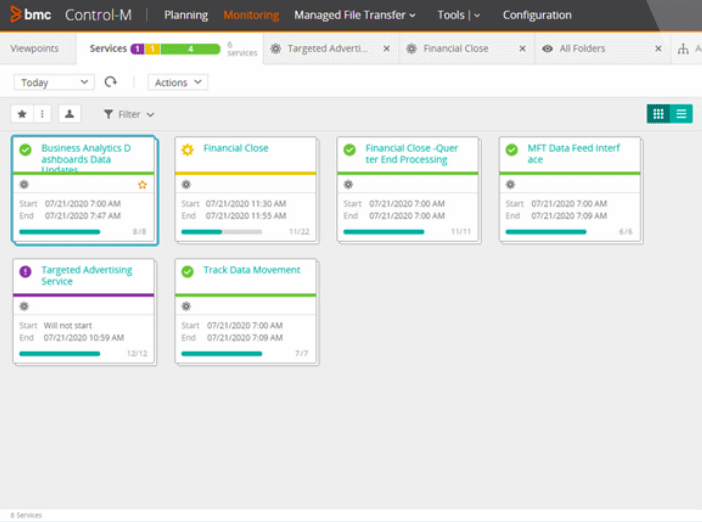
Control-M is another best Automic alternative that simplifies the orchestration of application workflows. It makes it easier to define, manage, schedule, and monitor workflows so as to improve SLAs and get deeper visibility into processes. It is the best solution for the management of complex business workflows.
Key Features:
- Advanced Workflow Orchestration Capabilities: Links to any data source, application, and record system
- Full Control: Integrated intelligent file visibility and movement to give complete control over file transfer processes.
- Integration: Integrates workflow orchestration directly into your continuous integration/continuous deployment pipeline to accelerate the release of new business applications.
- Data Workflow Management: Data-driven results by effectively managing big data workloads
Why do we recommend it?
Unlike a few other tools, Control-M follows the Jobs-as-Code approach that helps businesses scale collaboration between Dev and Ops teams. It facilitates the creation, scheduling, management, and monitoring of production workflows, guaranteeing transparency while enhancing SLAs.
Control-M offers various functionalities to help you build, define, monitor, and schedule production workflows. The tool can be deployed as a service or on-premises. You can integrate it with GCP (Google Cloud Platform), Azure, and AWS, as it can simplify workloads throughout your multi-cloud and hybrid environments.
Who is it recommended for?
Organizations of all sizes and in all industries can use Control-M to automate and orchestrate complex workflows smoothly. Dev, Ops, and other business lines may effortlessly utilize Control-M's advanced operational capabilities.
Pros:
- Custom Dashboard: Monitors using a straightforward but informative dashboard that can be customized as per the need
- Compatibility: Supports and works well with a variety of operating systems, including Windows, Linux, and macOS
- Simplify Workflows: Utilize Google Cloud Platform (GCP), Azure, and Amazon Web Services (AWS) connections to streamline processes in hybrid and multi-cloud environment
- Collaboration: Employs a Jobs-as-Code approach to facilitate the growth of Dev and Ops team collaboration
Cons:
- Visualization Options: Supports only a few workflow visualization options
- Not Suitable for Non-Technical Users: Users with no technical background or expertise might not find it a perfect solution
Website Link: https://www.bmc.com/it-solutions/control-m.html
5. JAMS
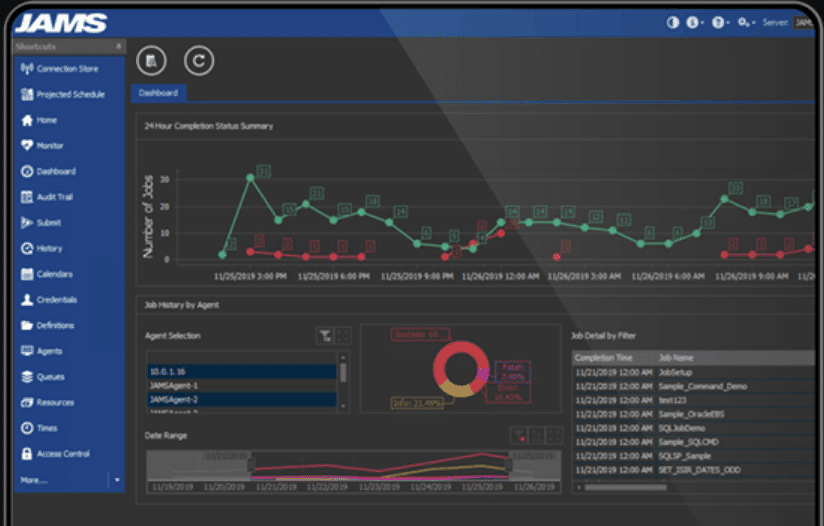
JAMS is an enterprise-grade workload automation solution that simplifies and manages IT processes right from scripts, batch processes to complex cross-platform workflows comprising jobs from multiple applications and servers.
Key Features:
- End-to-End Workload Automation: Automates the process of execution, supervision, task management, and workflows supporting essential business operations.
- Alerts and Notifications: Alerts about job failure and resolve the matter before it affects your company.
- Flexibility: Allows simple automation of file transfers, ETL, scripts, ERP operations, and business intelligence
- Financial Batch Processing: Centrally handles job management through a single console
Why do we recommend it?
Instead of the other way around, JAMS works well with your dependencies and schedule. Using event-based scheduling that leverages dependencies and triggers to start jobs, you can manage your environment the way you want. Its robust engine and alert features activate when a remediation workflow fails.
With JAMS, you can effectively define, execute, schedule, and monitor jobs all via a single intuitive console. Having a centralized control saves enterprises money and time, and helps meet compliance standards and mitigate risks to help businesses deliver value. Jobs running on cloud resources, on-premises, or in multi-step workflows execute seamlessly and securely throughout.
JAMS is a flexible tool that can meet the needs of any enterprise, regardless of its size. It has a reliable and robust engine with alerting features that trigger when a workflow fails in remediation. Plus, it offers solid support from a team of expert engineers.
Who is it recommended for?
Any size business can use JAMS because it is a versatile tool that can satisfy its demands. But, it is a perfect solution for mid to large sized businesses as small businesses might not benefit much from the wide range of JAM Schedulers options.
Pros:
- Monitoring Capabilities: Monitors assets across several workflows with ease
- Job Distribution: Capable of allocating jobs to several resources in order to meet peak demand
- Saves Time: Responds to problems and failures more quickly and intelligently with real-time alerts
Cons:
- Not Ideal for Small Businesses: Some of JAM Scheduler's features might not be useful for smaller businesses.
Website Link: https://www.jamsscheduler.com/
6. IBM Workload Automation

IBM Workload Automation is a power-packed, all-in-one solution for batch and real-time workload automation. It is available for processes hosted in the cloud or those on distributed mainframes.
Key Features:
- Predictive Analytics: Uses historical data and other techniques to manage workload and make informed decisions
- Custom Dashboard: Enables the use of built-in widgets to customize workload dashboards
- Seamless Integration: Allows for the smooth integration of over 35 business integrations with key business apps
Why do we recommend it?
IBM Workload Automation is an all-in-one solution that helps automate complex workloads, schedule application development and testing, as well as offers a single point of control. It even supports the variable passing feature that helps transfer data between jobs and job streams.
IBM Workload Automation is one of the best Automic alternatives that can optimize and automate complex IT workflows to boost efficiency. It is an analytics-based solution that can drastically boost the way you simplify and manage business processes. IBM solution also comprises an intuitive and powerful dashboard and modern streamlined container architecture to simplify the management and deployment of workloads.
Who is it recommended for?
A wide range of industries and businesses can use the robust tool to manage complex and diverse IT workloads as well as streamline batch processes. It even supports monitoring SAP and non-SAP applications as well as other features that are applicable to medium-sized and enterprise-tier organizations.
Pros:
- Graphical Representation: Effectively illustrates automation progress and health through graphics
- Several Features: Helps sysadmins to replicate operations before going live and provides a wide range of planning features.
- Proactive Incident Resolution: Spot anomalies in workloads and resolve incidents faster
Cons:
- Exploration: Users might take enough time in order to fully explore its features and functionalities
Website Link: https://www.ibm.com/products/workload-automation
7. Stonebranch
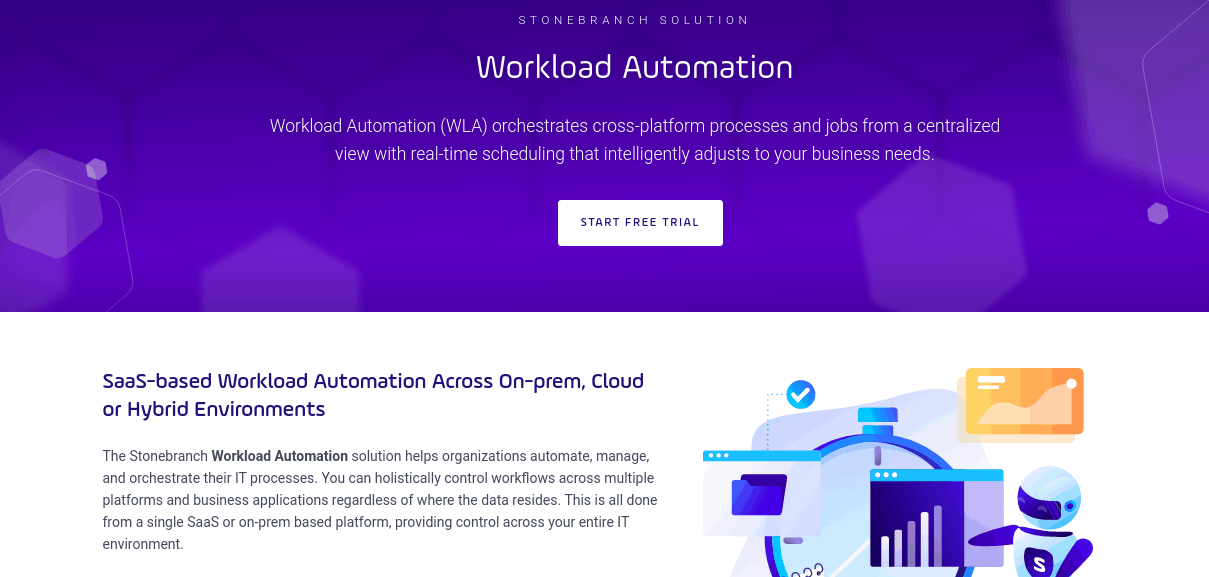
The Stonebranch Workload Automation is designed to help organizations manage, automate and orchestrate IT processes across the entire hybrid environments. It is one of the best Automic alternatives for real-time hybrid automation.
Key Features:
- Centralized Management: Centralizes automation effectively, even on complex networks
- Drag-and-Drop Options: Makes it easy to create workflows
- Self-Service Automation: Uses member roles and permissions to enable self-service automation
Why do we recommend it?
Stonebranch is a unified platform for event-based IT automation solutions that can operate both on-premises and in the cloud. It is a scalable solution with a user-friendly interface that reduces the learning curve and improves efficiency.
Stonebranch is a modern tool developed mainly for workflow orchestration. The powerful hybrid automation platform can orchestrate IT workloads, jobs, and tasks distributed on-premises or on the cloud environments. It supports on-premise as well as SaaS deployments. Apart from this, it can also be used for DevOps automation, cloud automation, hybrid cloud file transfers, and more.
Who is it recommended for?
Organizations from different industries can utilize the tool for managing batch processes, data transfers, and other complex application workflows.
Pros:
- Automation: Users can automate tasks across multiple clouds and on-premises environments easily
- Chains of Automation: Automate your surroundings with ease by turning them on and off in chains
- Unlimited Third-Party Integration: Provides infinite integrations with third parties as well as supports integration blueprints from open-source markets
Cons:
- Multi-Tenant Features: Would be better if the tool offered additional multi-tenant features
Website Link: https://www.stonebranch.com/
8. AutoSys
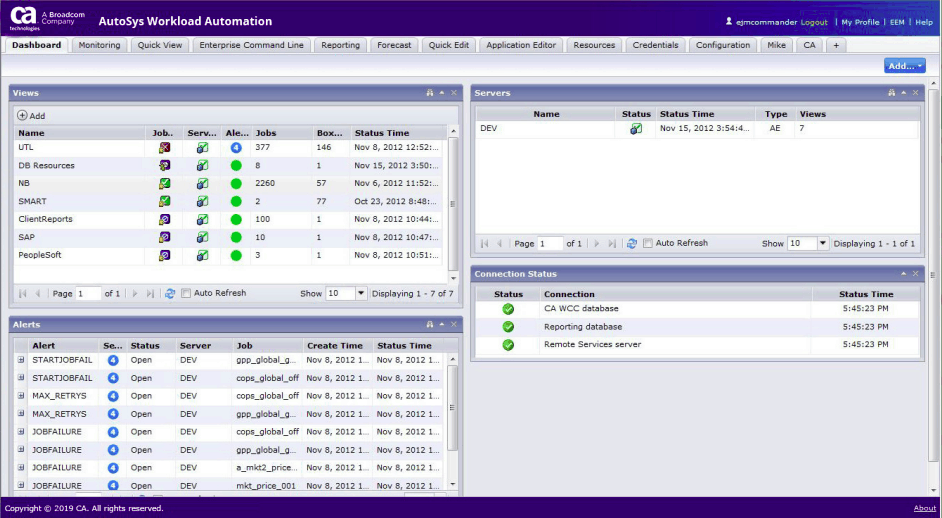
AutoSys is the best Automic alternative for complex, business-critical workloads. It is a powerful solution used to define, schedule, and monitor jobs across your entire workload infrastructure.
Key Features:
- Multi-Platform Scheduling: Utilize a central point of control to oversee and visualize a business process from end-to-end across platforms.
- Web Service: Helps development teams to create queries using an automation engine and a web service.
- Advanced Features: Provides advanced features for managing relationships between jobs in Hadoop and traditional work environments.
Why do we recommend it?
Autosys provides end-to-end visibility and full control, and businesses can better manage complex workloads across platforms as well as cloud-based ERP systems. It even contributes to the constant service delivery by lowering the cost and complexity of managing mission-critical business processes.
AutoSys provides deeper visibility and enhanced control over complex business workloads. It can automate workloads distributed over ERP systems, diverse platforms, and cloud environments. You can deploy the tool partially or entirely on-premises, in the public, private, or hybrid cloud environments.
Who is it recommended for?
Developers and enterprises with complex environments might find AutoSys a suitable option. The increased cross-enterprise visibility allows team members to manage workloads for several business applications seamlessly.
Pros:
- SOAP and REST: Provides native support for web service protocols, including REST and SOAP.
- Self Service: Allows end users to request and carry out workload processing that is governed by governance and workload policies.
- Better Security: Defines access rights at every level to better comply with regulatory compliance standards
Cons:
- Not Suitable for Smaller Organizations: Small businesses or organizations with simple workflows might not use some of its advanced features
Website Link: https://www.broadcom.com/products/software/automation/autosys
9. Red Hat Ansible
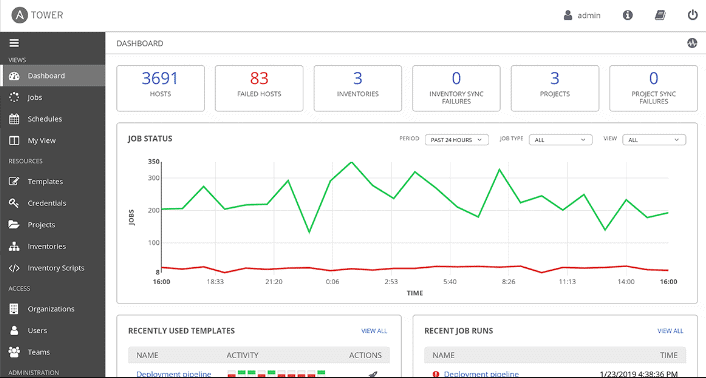
Red Hat Ansible is a feature-packed automation platform that drives automation across your open hybrid cloud deployments. It is an ideal solution for automating IT infrastructure and applications. You can use the tool even if you don't have much knowledge of code.
Key Features:
- Integration: Enables agentless and easier automation by integrating OpenShift Container with Ansible Automation Platform.
- Kubernetes Management: Manages native Kubernetes management along with containers. It also provides support for several Kubernetes frameworks and tools
- Virtualization Platforms: Offers support to RHV, Vagrant, VMware vSphere, and other virtualization platforms
Why do we recommend it?
Sharing automation across your company is simple using the Ansible Automation Platform. With just one subscription, it offers all the features required to design, implement, and monitor automation.
Apart from automation, Ansible can be used for provisioning, app deployment, configuration management, continuous deployment, continuous delivery, orchestration, and security compliance. With Ansible, you can convert tasks into repeatable playbooks. With just a click of a button, you can roll out protocols across your entire enterprise.
Who is it recommended for?
Both small and large dev teams can utilize the tool to speed up their production and manage complex deployments. It comes with a wide range of features and benefits that make it a great option for most enterprises.
Pros:
- Excellent Interface: Offers both easily accessible details and high-level insights
- Infrastructure Integrations: Supports Windows, ServiceNow, Red Hat, HPE, and VMware infrastructure integrations
Cons:
- Time-Consuming: Provides a wide range of options, some of which may require time to thoroughly explore
Website Link: https://www.ansible.com/
10. Azure DevOps Server
Azure DevOps Servers consists of a diverse range of collaborative software development tools that allow businesses to share code, monitor workloads, and ship software. It supports on-premises development.
Key Features:
- Extensions Marketplace: Provides access to over 100 apps and services.
- Supports Integration: Allows for integration with your existing IDE and Azure tools
- Azure Repos: Gives unlimited access to private Git repos stored in the cloud
Why do we recommend it?
Azure DevOps Server comes with a wide range of integration options that facilitate seamless collaboration between team members. Furthermore, users can add artifacts to CI/CD pipelines, track changes to code, run automated tests and release orchestration using this tool.
Who is it recommended for?
This tool is best suitable for DevOps Teams and large enterprises as it comes with several integration tools that help businesses standardize processes and improve collaboration with teams.
Pros:
- Easy to Install: Requires no specialized server and may be installed quickly on a desktop or laptop
- Data Security: Over 3,500 security professionals are committed to data security and privacy
Cons:
- Not for All Organizations: Designed particularly for individuals who utilize Azure
Website Link: https://azure.microsoft.com/en-us/services/devops/server/
11. OpCon
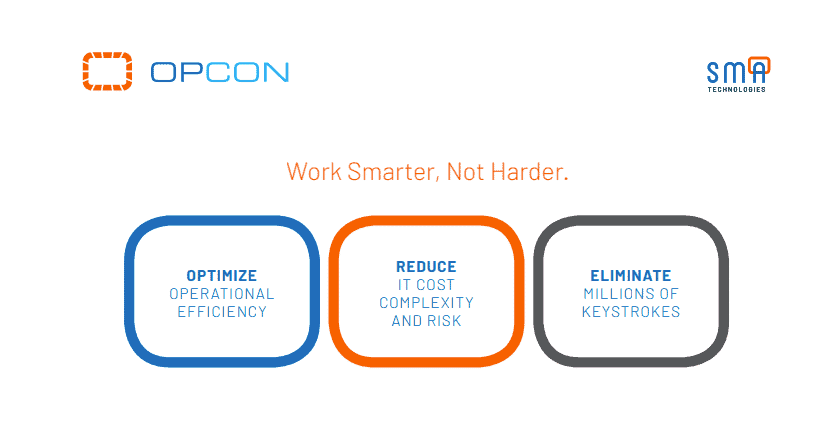
OpCon is a robust and flexible platform that is able to scale up per your requirements. It can run over 140, 000 jobs across multiple operating systems and environments. It can help you seamlessly shift from traditional platforms to new, technology-driven platforms with the help of industry-leading expertise, a rich library of legacy connectors, and REST APIs.
Key Features:
- ACH Processing: Aids in file detection and initiates schedules automatically.
- End of Day Processing: Eliminates the need for irregular hours and late shifts by performing 24/7 lights-out processing tasks
- Share Draft and Checking: Automates schedules and provides a smooth user experience while lowering manual key-entry errors
Why do we recommend it?
OpCon is a highly scalable, flexible, reliable tool that minimizes errors in business operations by creating, modifying, and managing all automation processes. It provides information on the efficiency metrics for ongoing improvement, resource usage, and workflow execution.
Who is it recommended for?
OpCon's primary purpose is to meet the automation needs of enterprise-level networks with complex infrastructures; small networks may not find it ideal for their purposes, but large businesses with complex IT systems may find it useful.
Pros:
- Easy-to-Use Interface: Provides full operational control over even the most complicated environments
- Disaster Recovery: Runs self-healing processes to continue operations in the event of unanticipated system failures or disruptions
Cons:
- No Free Trial: It would be nice to have free trial sessions for testing its features
Website Link: https://smatechnologies.com/opcon-automation
Conclusion
Businesses need to leverage a powerful solution to orchestrate their entire tech stack and centralize workload automation and job scheduling. The tools need to be flexible, reliable, and fast enough to provide unparalleled extensibility and optimization of workflows. These tools also need to have low-code, drag-and-drop GUI for ease of use.
The Automic Automation tool is no doubt one of the best tools available for workload automation. But if you’re looking for Automic Alternatives, then ActiveBatch and other alternatives mentioned here are quite intuitive, reliable, and offer good customer support.
